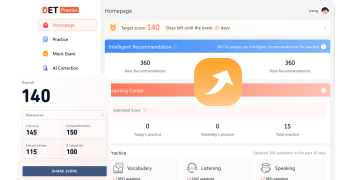デュオリンゴ英語テストにおける「読む、それから書く」チャレンジの攻略
English言語を愛好する皆さん、そしてDuolingo English Testの受験者の皆さん、ようこそ!今日は、試験の中でも重要な部分である‘Read, Then Write’セクションに取り組みます。このセクションは、あなたの英語の読解力と作文能力を効果的に測定するために設けられています。多くの人がこのセクションを時間制限や必要な深い回答のために難しいと感じるかもしれません。しかし、心配はいりません!この投稿は、このセクションに自信を持って取り組むだけでなく、それをマスターするための戦略的ガイドです。
‘Read, Then Write’タスクでは、提示された課題に対して5分間で回答を作成します。難しそうに聞こえますよね?しかし、適切なアプローチを取ることで、この挑戦を英語の能力を示す機会に変えることができます。あなたが英語に精通しているか、言語学習者であるかに関わらず、このガイドは実践的な戦略、時間管理のヒント、さらには成功を保証するための回答テンプレートを提供します。それでは、一緒にこの旅に出発し、あなたのライティングスキルを良いものから素晴らしいものへと変えていきましょう!
課題を理解するヒントや回答の構成方法、語彙を豊かにする方法など、実践練習を正しい方向に導く適応可能なテンプレートの紹介とともに、インサイトフルなヒントをお楽しみください。‘Read, Then Write’セクションで高得点を目指す準備はできましたか?さあ、始めましょう!

1. 課題の理解:ターゲットに絞った回答の鍵
‘Read, Then Write’セクションへの取り組みは、まず課題を理解することから始まります。このセクションでは、言語スキルだけでなく分析力も求められます。以下に、正しい方向に進むための方法をご紹介します:
まず、課題を分解しましょう。その基本的な要素に分解します。主要なトピックは何か?特定の詳細や比較が求められているか?これらの要素を特定することが、関連する回答を作成するために必須です。
次に、質問のタイプを特定します。それは、アイディアを例を使って説明する記述的な回答を求めているのか、それとも立場を取る議論的な回答を求めているのか?この違いによってあなたのアプローチが決まります。
最後に、指示語に注意を払いましょう。‘describe’や‘compare’、‘argue’などの言葉が、試験官が何を求めているかを直接示しています。これを無視すると、間違った方向に進んでしまう可能性があります。
例えば、「新しいことをするのに恐怖を感じた最後の時について話してください。ただし、それを行うための強さをどのように見つけたのか?この経験から何を学び、それが今後の人生にどのように役立つか?」という課題を考えてみましょう。
これを分解するために、3つの主要な要素を特定します:恐怖の個人的な経験、その恐怖を克服したこと、そして学んだ人生の教訓です。これは、出来事を再現するだけでなく、個人的な洞察も求められる記述的であり、反省的でもある課題です。
行動語を特定します:話す、‘found the strength’、‘learned’。これらは、物語を共有し、内なる強さを反映し、広範な人生の教訓を抽出するように指示します。
このような課題は、単に何が起こったかを尋ねるものではありません。それは、あなたに旅を語り、その影響を反映するように招待しています。これを完全に理解することで、あなたの回答は単なる物語を再現するのではなく、個人的な成長の一端も提供し、課題が求めるものと完全に一致することになります。
覚えておいてください、課題はあなたのロードマップです。それを理解することは、最初のステップであるだけでなく、評価者に響く魅力的な回答の基盤です。ですから、一瞬立ち止まり、慎重に読み、明確さがペンを導くようにしましょう!
2. 時間管理のマスター:
わずか5分で回答する場合、時間管理のマスターが重要です。ここでは、戦略的な内訳をご紹介します:
迅速に計画を立てる:アイデアを出し、アウトラインを作成するのに1分を費やします。アイデアと主張したいポイントを書き留めます。
効率よく書く:3分を執筆に割り当てます。アウトラインに従い、文を簡潔に保ちます。明瞭さと正確さを目指します。
効果的に校正する:最後の1分を校正に充てます。文法の誤りを確認し、課題のすべての部分に答えているかを確認し、不自然な表現を修正します。
時間を賢く構成することで、回答が一貫していて、清潔で、完璧なものになります。未完成の傑作よりも、制限時間内に仕上げられた洗練された回答の方が優れています。
3. 回答の構造化: 簡潔かつ明瞭に保つ
‘Read, Then Write’セクションは、5分しかないので、シンプルさが鍵となります。ここでは、明確で効果的な回答を構築する方法をご紹介します:
導入:課題に直接取り組む簡潔な文で始めます。課題が個人的な経験についてであれば、状況を設定する簡潔な声明で始めます。
本文:展開する1つまたは2つの主要なポイントを選びます。経験を述べる場合は、最も影響力のある部分に焦点を当てます。議論する場合は、主な理由を述べ、それを簡潔にサポートします。
結論:経験を反映し、またはポイントを再確認する短い締めくくりで終わります。響くようにし、簡潔に保ちます。
このシンプルな構造は、回答を整理し、課題に集中し続けることを保証し、限られた時間を最大限に活用できます。
例題「Talk about the last time you felt scared to do something new, but you did it anyway. How did you find the strength to try it? What did you learn from this experience that will help you in life?」に対して、
シンプルな構造を示しましょう:
導入:「Facing my long-standing fear of heights, I decided to try rock climbing, an activity that both terrified and intrigued me.」
本文:「Initially, the very thought of climbing filled me with dread. However, recognizing the importance of confronting my fears, I started with small, manageable climbs. I sought guidance from experienced climbers and gradually built my confidence through their support and my persistent practice. This journey was not just about climbing but about learning to trust in my abilities and the support of those around me. The moment I reached the top of my first significant climb, the overwhelming sense of achievement eclipsed any fear I had felt.」
結論:「This experience taught me that facing fears head-on, with preparation and support, can lead to profound personal growth.」
この例は、導入、本文、および結論のシンプルな構造に従い、5分のライティングタスクに適した一貫性のある効果的な回答をまとめています。
4. 深さを重視: 充実した回答を作成する
‘Read, Then Write’セクションでは、多くをカバーしようとするのではなく、深さに焦点を当てることが重要です。これは、1つまたは2つの重要なポイントを選び、それを詳細に掘り下げることを意味します。具体的な例や個人的な洞察を使用して、豊かでニュアンスのある回答を提供してください。このアプローチは、批判的かつ反省的に考える能力を示すだけでなく、あなたの文章が魅力的で意味のあるものにすることができます。トピックを深く理解していることを示し、それが評価者に印象づける回答を生み出します。
5. 言語と語彙: 正確さと多様性の芸術
‘Read, Then Write’セクションでは、多様で正確な語彙を使用することが重要です。考えや感情を正確に伝えるため、具体的で表現力豊かな言葉を目指しましょう。これは、読み手を混乱させる可能性のある過度に複雑な言葉や珍しい言葉に頼るという意味ではありません。代わりに、明瞭さと正確さを追求してください。同義語を慎重に使うことで、理解しやすさを損なうことなく、テキストに豊かさを加えることができます。さらに、正しい文法と文の構造は、あなたのアイデアを効果的に伝え、評価者に良い印象を与えるために不可欠です。
語彙を多様で正確にし、回答を磨くためには、次のような改善案を考慮することができます:
導入:「Confronted by my perennial dread of altitudes, I embraced rock climbing, a venture that both daunted and captivated me.」
本文:「The notion of ascending vertical faces initially paralyzed me with fear. Acknowledging the necessity to confront my apprehensions, I embarked on modest ascents, under the tutelage of seasoned climbers. Their mentorship, coupled with my steadfast dedication, gradually fortified my confidence. This odyssey was not merely about climbing; it was an expedition in self-discovery and trust. Achieving the summit of my inaugural significant climb was a testament to surmounting fears through perseverance and communal support.」
結論:「This odyssey illuminated the essence of bravery, tenacity, and the significance of stepwise progression. It underscored that engaging directly with one’s fears, equipped with preparation and camaraderie, catalyzes profound self-evolution. These lessons serve as invaluable compasses for navigating future adversities with a fortified resolve.」
このバージョンは、より豊かな語彙とより描写的な言語を使用して、経験を生き生きと反映させており、正確な言語選択が物語の深さと影響を強化する方法を示しています。
6. 成功のためのテンプレート: 異なる質問タイプに対する構造化されたアプローチ
‘Read, Then Write’ の質問に効果的に取り組むために、記述的および議論的な課題のためのシンプルなテンプレートを以下に紹介します:
記述的課題のテンプレート:
- 導入:状況や経験を簡潔に紹介します。
- 本文:経験を具体的な詳細で説明し、感覚的な情報や感情に焦点を当てて物語を生き生きとさせます。
- 結論:経験を反映し、個人の成長や得られた洞察に焦点を当てて締めくくります。
議論的課題のテンプレート:
- 導入:あなたの立場を明確に述べます。
- 本文:具体例や証拠を用いて、1つまたは2つの強力な論点を提示します。
- 結論:立場を再確認し、論点があなたの立場を支持する方法を要約します。
これらのテンプレートは、明確で焦点を絞った回答を構築するための青写真として機能します。課題に基づいてカスタマイズすることが、魅力的な回答を提供する鍵です。
7. 校正の実践: 注意深さによる品質向上
校正は、あなたの‘Read, Then Write’の回答を光らせるための最後の重要なステップです。この段階は、単にタイプミスを探すことだけでなく、明瞭さ、一貫性、インパクトを向上させるための包括的なレビューです。このプロセスには少なくとも1分を割き、次のステップに従ってください:
1. 完全性の確認:課題に戻り、すべての側面に対処しているか確認します。質問の一部を見逃すと、スコアに大きく影響します。
2. 文法と構文のレビュー:主語・動詞の一致、時制の誤用、修飾語の位置などの一般的な文法上の誤りをチェックします。文がスムーズに流れ、句読点の使用が読みやすさを増していることを確認します。
3. 語彙と明確さ:単語の選択が正確で文脈に適しているか確認します。曖昧な用語を具体的なものに置き換えて、ナラティブや議論に深みを加えます。
4. 論理的な流れ:アイデアの整理を評価します。各段落が次へスムーズに移行し、論理的な進行が維持されていることを確認します。
5. 冗長性の排除:繰り返しの表現や不要な言
葉を取り除きます。簡潔さは、明確で強力な文章の鍵です。
6. 声に出して読む:テキストを声に出すことで、静かに読むと見逃す可能性のある不自然な表現や誤りを発見できます。
7. 最後のスペルチェック:スペルチェッカーを使用しても、同音異義語や誤った単語選択など、見逃される間違いがある場合があります。
これらの校正の実践を統合することで、あなたの回答は文法的に正しいだけでなく、より魅力的で効果的なものになるでしょう。この注意深い洗練プロセスは、あなたの文章を向上させ、評価者に強い印象を残すことができます。
この包括的なガイドを通じて、私たちは‘Read, Then Write’セクションを効果的にナビゲートするための基本的な戦略と実用的なテンプレートを探求しました。課題を正確に解読し、貴重な5分を賢く管理し、クリアさと深みを強調するための構造を持った応答を作成し、多様な語彙でナラティブを強化し、入念な校正でドラフトを調整すること—それぞれの戦略が魅力的な回答を作成する上で重要な役割を果たします。覚えておいてください、このセクションでの優れた結果は、継続的な練習とこれらの技術の思慮深い適用から生まれます。これらの戦略を準備ルーチンに取り入れ、スキルを徐々に磨いていくことをお勧めします。それぞれの練習セッションが、あなたのライティング目標を達成するだけでなく、超えるためのステップとなり、DETでの成功へと繋がることでしょう。
詳細なDET準備戦略については、こちらをクリックしてください。
DETに関するヒントを探していますか?こちらで見つけてください:https://www.detpractice.com/category/pro-test-tips/
今すぐ無料で私たちの DET問題集にサインアップして、練習を始めましょう。






